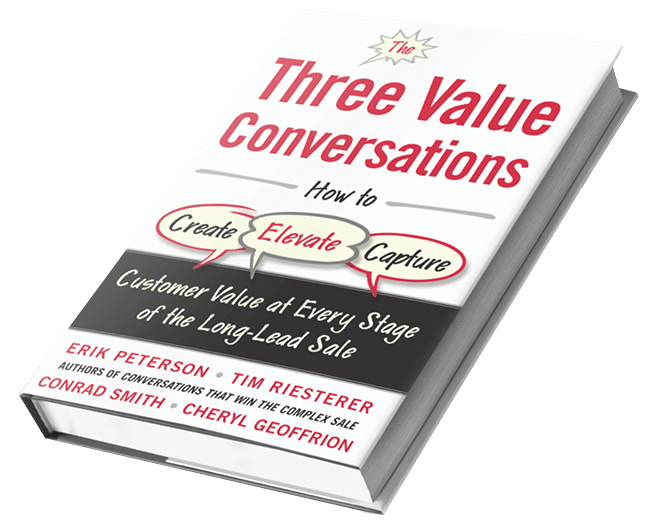The “Fourth Value Conversation”
18th December 2018 | Tim Riesterer
What is the “Fourth Value Conversation”? We asked Tim Riesterer, author of The Three Value Conversations.

Q: What is the “Fourth Value Conversation” and why is there a need for it now?
We’re calling it “Expand Value”. It’s that part of the customer conversation lifecycle where you’re looking to ensure more renewals, communicate price increases and generate upsells and cross-sells – in other words, when you are trying to “expand” the value of the customer relationship to your organization. Analysts estimate that 70-90% of revenue and profits each year result from these activities.
However, most business development and sales methodologies are based on and built for prospecting and new logo acquisition. Our research shows that the psychology of prospects and existing customers is completely different. And, that you need a different approach in your stories and your skills to engage them most effectively.
Q: What is the central difference in how new customers respond to your messaging versus how existing customers respond to your messaging – and how do you need to adapt your messaging to engage each group appropriately?
Simply put, with prospects and new logo acquisition you must focus on disrupting their status quo bias. When you are the outsider and your competitor is the incumbent, your stories and skills must focus on showing the prospect what they are missing, and the risks of staying the same. You must answer the question “Why Change?” And, you must show clear, contrasting differentiation between your approach and the one they are currently taking.
However, with existing customers you must do the exact opposite. When you are the status quo, you should not seek to disrupt their status quo bias. You should defend and reinforce their status quo bias. It sounds obvious, but it turns out that many sellers use the same approaches to selling new logos as they do with existing customers. Or at least, they don’t take full advantage of the inertia that is on your side with existing customers.
Three’s good, but four’s better…
There’s something so neat, clean, and economical about clustering things in threes. See? I just did it there. Three of something, whether adjectives or bullet points, seem like the perfect amount of information—detailed enough to have substance, consumable enough to recall.
In fact, for these reasons, the “Rule of Threes” is a long-established speechwriting technique that many great orators have learned and mastered. Now, whether you need to place a comma between the second and third item may be up for debate. But the rhetorical power of the Rule of Threes is not.
But sometimes even the most sacred rules are meant to be broken. That’s my rationale for the story about I’m about to tell…
A few years ago, when a team of co-authors and I published the Three Value Conversations, we turned our focus (naturally) to three inflection points in the deal cycle that we thought – and still think – are fundamental to creating sales opportunities, bringing those opportunities through your pipeline, and negotiating a profitable close. The book was really about three moments of truth that occur in every deal cycle – three moments in which reps must:
- Create value by breaking through status quo bias and creating differentiation.
- Elevate value by delivering business proposals that meet executive standards.
- Capture value by driving consensus and negotiating effectively to close larger, more profitable deals.
Together, the three value conversations spanned the entire customer acquisition side of marketing and sales. This side of the customer conversation demands provocation and disruptive insights. It calls for edgy messaging and skills designed to overcome status quo bias and break down your prospects’ resistance to change. After all, that’s what our research revealed to be the message that’s most effective when you’re the outsider trying to displace an incumbent and to convince a prospect to change and choose you.
But once you’ve closed the deal, that’s kind of where it stopped. We assumed that what worked for new customer acquisition would translate to the key moments after the deal closed, when you need to retain and expand with existing customers. Nevertheless, we started hearing a certain question from some of our customers: the “Why Change/Why You” story (and the research supporting it) is great for when you’re trying to defeat the status quo, they would say. But what about when you are the status quo? What about when you need to protect your accounts and even expand with them?

It turns out the key customer retention and expansion scenarios you need to succeed in have a dramatically different buyer psychology than that of new customer acquisition. Thus, they demand different – in some cases, opposite – messaging and skills approaches. Where you need to disrupt the causes of status quo bias as the outsider, you need to reinforce them when you’re on the inside.
Cumulatively, the research reveals that the customer conversation isn’t a one-size-fits-all effort. Different moments require different messaging and skills. The interview below covers why the time was ripe for breaking the rule of threes and adding some strategy and structure to a fourth value conversation, dealing with customer retention and expansion.
Q: What are the critical customer expansion situations that salespeople need to be fluent in today?
There are three “expansion” opportunities we have researched and been able to prove a specific messaging framework for: renewals, price increases, and upsells.
Renewals are the lifeblood of the rapidly expanding subscription business model. So much money is spent on the initial sale that many customers don’t become profitable until after the first renewal. Part of that reason is the initial acquisition was under-priced to win the business, so not only do you need to renew the customer, you often have to pass along a price increase as part of that sales motion in order to reclaim the margins you need.
Then, you typically see companies taking a “land and expand” approach to selling on the acquisition side. It becomes imperative for growth that once you land the small starter project, you up-sell and cross-sell additional products and services to maximize the revenue potential of every account.
Q: Is there a difference in approach you might need to take between, say, a customer retention dialogue versus an upsell conversation? If so, describe the difference.
There’s a slightly different approach to each of the “Expand Value” conversations. Fundamentally, they all reinforce the existing relationship and positive momentum and results you have generated for the client. In the case of straight-up renewals, this is almost exclusively the emphasis of your message, but in price increases and upsells additional science and messaging components are required.
For price increases, we discovered that you must reinforce status quo bias followed by a price increase that is anchored high, and then discounted for a justifiable reason such as customer loyalty. For upsell, you still emphasise the existing relationship throughout the message, but you must interject some emotional language and elements of the Why Change story to get them to move to the upgrade. We describe it as a hybrid between our Why Change and Why Stay frameworks and call it Why Evolve.
Our research shows there are differences in the message and resulting skills needed between customer acquisition and customer expansion.
Q: Should a fourth value conversation be the domain of a different part of the sales force –the “farmers” rather than the “hunters” – ie, segment the salesforce along with the customers? Would that work as a strategy?
What our research shows is that there are differences in the message and resulting skills needed between customer acquisition and customer expansion. In the first case, sellers must be disruptors. They must have the messages, skills and confidence to challenge the status quo bias. In other words, sellers must be defenders and expanders. They must have the messages, skills and confidence to reinforce status quo bias.
We have a client where the same sales team is selling a product with 10% market share and they must aggressively disrupt the incumbent. However, those same salespeople also represent a product in a different category where they have 80 percent share and must fend off competitors daily, protect share, and communicate price increases. So, either you must prepare and teach your reps to be situationally fluent enough to win in both cases, or you may want to consider dedicated sales teams that focus their energies and skills on either the acquisition or the expansion side.
Q: Will there be an updated version of the Three Value Conversations book coming out soon to incorporate this research?
We have created an eBook called To Challenge or Not to Challenge that shares the science and frameworks around each of the messaging situations we’ve researched. Both on the acquisition side and expansion side. The good news is it’s free and you can get it here: https://corporatevisions.com/content-library/ebook-to-challenge-or-not-to-challenge/.
It takes a long time to write books and get them published, and we wanted to make these findings available as soon as we discovered them. But, yes, we are working on our next book based on the last three years of research projects focused on customer conversations. We’ve got 12 studies that will make for a nice book with each study representing one counterintuitive, research-backed idea that will give sellers a competitive advantage. Look for it later in 2019.



